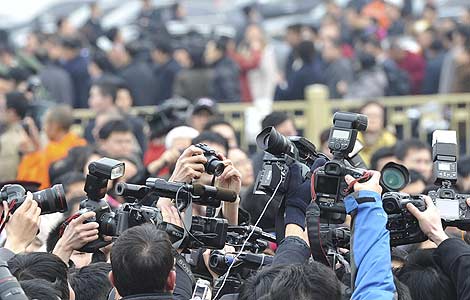China air standards going national by 2016
Updated: 2012-03-03 07:28
(Xinhua)
|
|||||||||||
BEIJING - The revised air quality standard that includes an index of PM2.5 will be implemented throughout the country by January 1, 2016, said an environment protection official on Friday.
"The new standard will be extended to all cities at prefecture level or above in 2015, and January 1, 2016 is the deadline for its implementation throughout the nation," said Wu Xiaoqing, vice minister of the Ministry of Environmental Protection.
Wu's words came after the State Council, or China's Cabinet, on Wednesday passed revised air quality standards that include indices for ozone and PM2.5, fine particulate matter 2.5 microns or less in diameter.
The government decided to monitor PM2.5 in four municipalities, 27 provincial capitals, as well as three key regions -- east China's Yangtze River Delta, south China's Pearl River Delta, and the northern Beijing-Tianjin-Hebei area -- this year.
Wu said that two-thirds of China's cities cannot meet the recently updated air quality standard, adding that air pollution control will be "an arduous task for the country."
"But that doesn't mean air quality is deteriorating in these cities," Wu said. "It is because the appraisal standards have been raised."
PM10 was previously used as part of the country's air quality standards before being replaced by the PM2.5 index, which measures finer particles that are considered more hazardous to health than larger ones.
Stressing the focus is on improving air quality rather than its monitoring, Wu said his ministry is working on a five-year plan for air pollution prevention and control in key regions, aiming to reduce the amount of fine particles in the air by strengthening controls over industrial waste treatment and auto emissions.
The vice minister urged local governments to formulate plans for meeting the new standard, raise environmental access requirements for enterprises and invest more in pollution treatment.
The amended standards also impose stricter limits for several types of pollutants and specify new analytical methods for pollutants such as SO2, NO2 and particulates.
Wu described the new standard as a "significant milestone" in the country's environmental protection efforts, as it marks a transformation from pollution control to environmental quality management and risk prevention.
The new standard "generally" follows international practice, Wu aid, admitting China still has a long way to go to meet the guiding limits set by the World Health Organization.
By the end of last year, 56 cities in China had been able to monitor PM2.5 or O3, with 169 sets of equipments ready for such monitoring.
Wu said another 1,500 monitoring sites will be built across the country in four years, with an initial investment of 2 billion yuan ($317 million).
With regards to some embassies in Beijing monitoring air quality and releasing results, the vice minister said air quality monitoring should adhere to relevant technological regulations which involve the location of the monitoring sites, and the analytic methods and equipment.
The accuracy of the monitoring can be ensured only by strict statistics quality control and guarantee measures, said Wu, adding that civilian's monitoring results can be used for reference.
The revised standard is consistent with the internationally accepted standard and technological regulation, Wu said, suggesting that the practice of assessing the air quality of a region in hours by a daily mean of PM2.5 is unreasonable, and can't truly represent the air quality in that region.
According to the new standard, Beijing will release in real time the concentration of six pollutants including PM2.5, O3 and SO2, and the individual air quality index recorded at each site, making the monitoring more comprehensive and representative, said Wu.
"So far, the monitoring sites in Beijing have covered the area hosting foreign embassies, which may have met the needs of embassy staff for learning about the air quality in Beijing," added Wu.
The new standard stresses the protection of people's health as the prime objective. It will remove the inconsistency between existing air quality results and public feelings, which also counts much in boosting the government's credibility and international image, said Wu.
Hot Topics
Wu Ying, iPad, Jeremy Lin, Valentine's Day, Real Name, Whitney Houston, Syria,Iranian issue, Sanyan tourism, Giving birth in Hong Kong, Cadmium spill, housing policy
Editor's Picks

|

|

|

|

|

|






